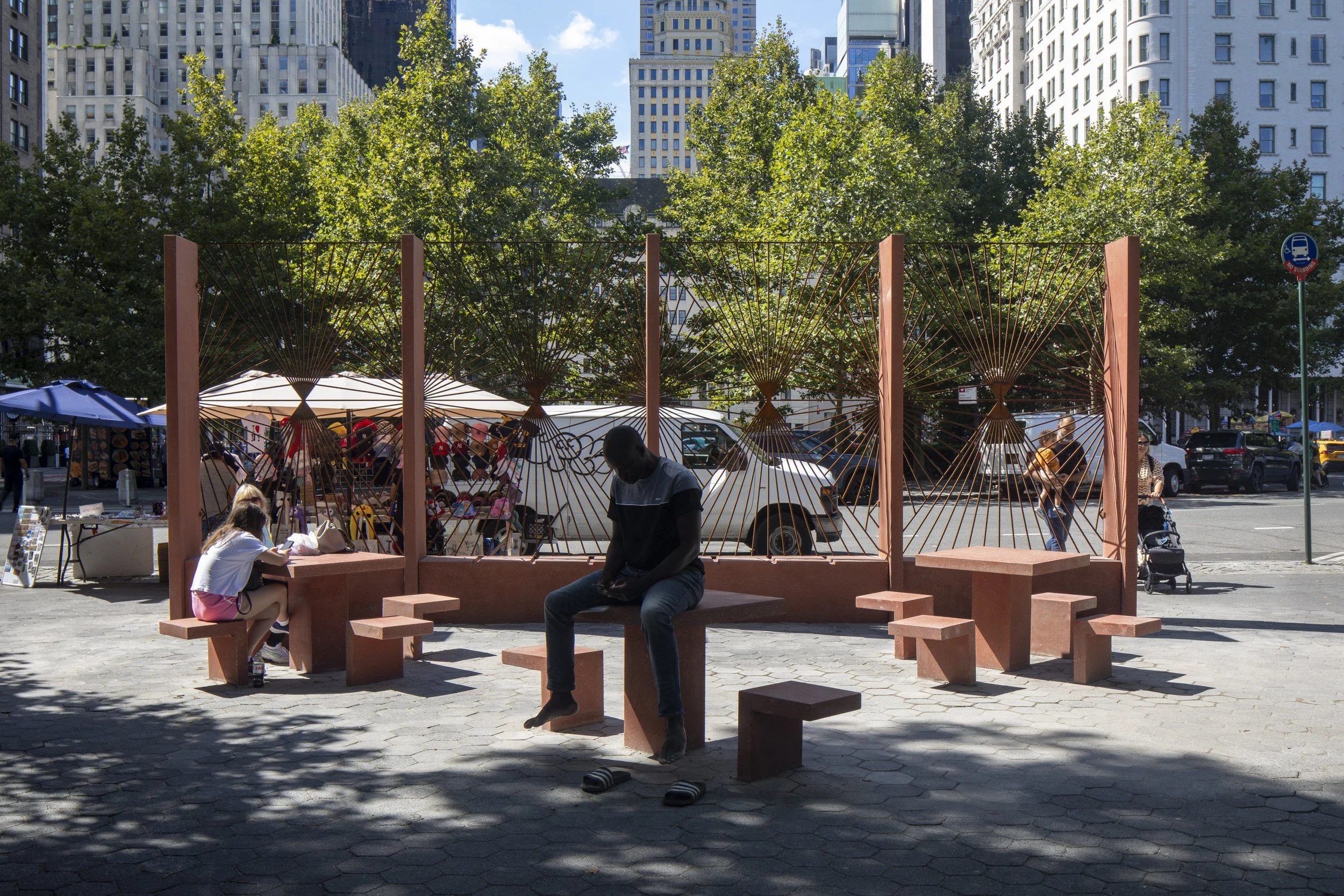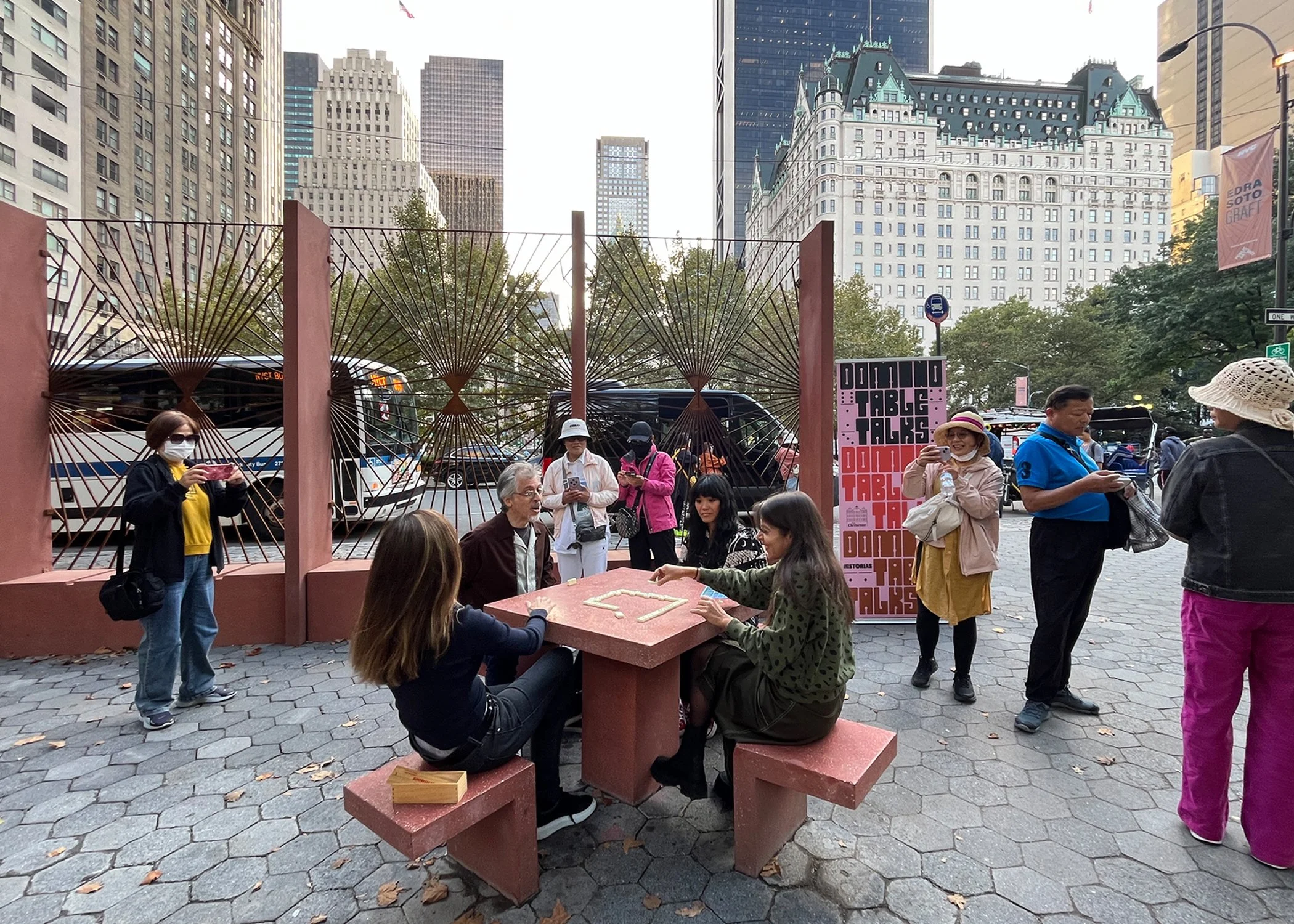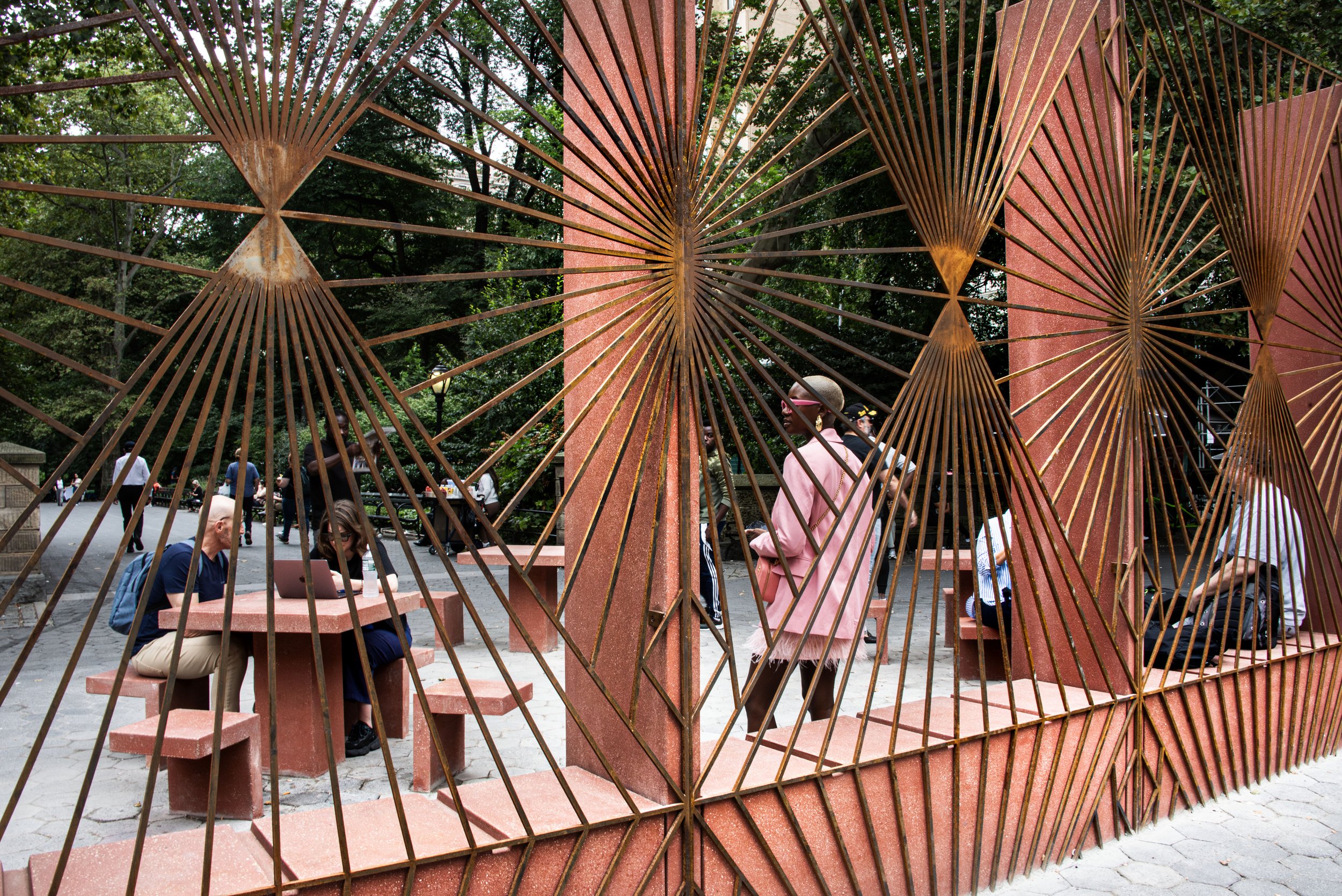Edra Soto: Public Art as Belonging
In the Doris C. Freedman Plaza at the southeast entrance of Central Park, Edra Soto’s Graft installation rises like a fragment of a different belonging: at once ornamental and ruinous, familiar and estranged. Commissioned by the Public Art Fund under the direction of Melanie Kress, this is Soto’s largest and probably most visible work to date in New York City.
Planted amid Manhattan’s imperial axis on Fifth Avenue, the installation transposes the architectural language of Puerto Rican suburbia into the core of the American metropolis. With materials like fences, screens, and floors from working-class neighborhoods on the island, Soto composed a structure that seems torn from a house in an abandoned subdivision, now resited in one of the most symbolically charged landscapes of the United States. Its weathered latticework and domino tables conjure not the sanitized short-term vacation rental of a gentrified Caribbean home but the memory of lived spaces, of communities in transition, of vernacular forms that persist as testimony and claim.
Architecture is an expression of culture, a gesture of identity inscribed upon the land. It is a human landscape imposed upon a natural one, and therefore, always a text of belonging, aspiration, and status. In Puerto Rico, vernacular architecture is not an official visual language but a criollo idiom that springs from rural experience, the availability and affordability of concrete block and terrazzo, and a cultural inheritance encoded in rejas—wrought‑iron lattice screens that trace back to Yoruba symbol systems from West Africa, filtered through Spanish colonial decorative grammar and Caribbean climatic adaptation.
The postwar era, particularly following the 1950s, marked a pivotal shift in Puerto Rican society as rural agricultural life gave way to planned suburban developments. This transformation ushered in a new vernacular architecture—one characterized by ornamental concrete blocks, rejas, Miami windows, and tiled floors—that embodied aspirations for dignity and modernity, as well as a practical response to the demands of durability and protection in the face of natural disasters and the realities of suburban living.
Yet within this architectural language lay an undercurrent of unease: the anxiety of transitioning from isolated, agrarian homesteads to densely populated neighborhoods, of coexisting with unfamiliar neighbors, of safeguarding the domestic interior. In this context, decorative screens and concrete blocks functioned not only as aesthetic embellishments or sources of ventilation but also as subtle instruments of spatial control. They delineated the fragile boundary between visibility and concealment, openness and defense, beauty and fortification, but most importantly, the private and the public space.
With the onset of Puerto Rico’s recent economic crisis—officially declared in 2016 with the enactment of the Puerto Rico Oversight, Management, and Economic Stability Act (PROMESA)—the pace of construction has slowed dramatically, and widespread disrepair has set in. Vernacular forms that once signaled aspiration and modernity have become weathered, often left in a state of visible decay. Ironically, this arrested development has frozen much of the built environment in a late 20th-century aesthetic. The result is a landscape suspended in time, where architectural details of another era linger as both ruin and relic. In this context, the language of vernacular architecture has acquired a dual resonance: It is both nostalgic and iconic, a visual marker of cultural continuity amidst infrastructural collapse.
This symbolic charge has not gone unnoticed by contemporary Puerto Rican artists. The decayed textures of urban and suburban architecture appear in the music videos and films of Macha Colón, who blends performance, humor, and political critique through the lens of collapsing domestic environments and ways of living. Similarly, artists like Rogelio Báez Vega, Gamaliel Rodríguez and Adrián Román, have drawn on these architectural residues to explore memory, spatial neglect and documentation through their artistic practices. Most recently, the “casita” installed inside the Coliseo José Miguel Agrelot during Bad Bunny’s residency reinserted the aesthetic of Puerto Rican suburban housing into the heart of pop spectacle, transforming domestic vernacular language into cultural monument. In these varied works, the architectural grammar of rejas, terrazzo, and concrete screens endures not merely as an aesthetic residue but as an index of identity—stubborn, persistent, and marked by both crisis and creativity.
Soto’s Graft seizes this language and lifts it into the realm of public art, translating the domestic into the monumental. The architectural fragment becomes a sculptural proposition, a visual grammar that carries diasporic weight. Installed in New York, the vernacular of Puerto Rican suburbia becomes a counter‑architecture, an interruption of the imperial landscape in the language of the colonized. It is not nostalgia alone that animates this gesture, though nostalgia is present and, in itself, political. Longing becomes a form of resistance, a refusal to allow erasure to operate unchallenged. The fragment insists: We have always been here, even in pieces; our architecture is testimony.
The artist’s own diasporic trajectory deepens this reading. Based in Chicago, Soto works within a city fundamental to the identity of U.S. architecture, often considered the birthplace of modern American design. Following the Great Fire of 1871, Chicago emerged as a laboratory for innovation, giving rise to steel-frame construction and the ethos of the Chicago School, led by figures such as Louis Sullivan. Frank Lloyd Wright further expanded the city’s architectural imagination with his Prairie style, while Ludwig Mies van der Rohe brought the International style into sharp clarity through structures like Crown Hall and the 860–880 Lake Shore Drive towers. Chicago’s skyline—shaped by successive waves of experimentation—continues to function as a living archive of architectural ambition. The city’s ongoing self-reflection, crystallized in the Chicago Architecture Biennial, places Soto’s work in dialogue with a monumental architectural tradition. By implanting Puerto Rican vernacular elements into such a context—both in Chicago and in Manhattan—Soto stages a conversation about visibility, belonging, and the hierarchies of the built environment.
While monumental architecture aspires to inspire awe and convey power, the act of asomarse—to peek in, to lean, to allow a partial seeing that is also a showing—becomes central to Soto’s practice. Both request a different approach from the viewer, a different posture, a different sense of vulnerability.
In earlier works, such as her installation for the Whitney Museum’s no existe un mundo poshuracán, her piece invited viewers to crouch, stretch, and adjust their bodies to look through built frames at intimate photographs that came from the artist’s life and community.
The verb asomar, as the Real Academia de la Lengua Española defines it, means “to put out or show something through an opening or from behind some part.” It contains a duality: It is both an approach and a revelation, a gesture of curiosity and exposure. This double motion animates Soto’s installations, where architecture becomes a lens and a threshold, offering glimpses into diasporic experience while asserting its limits. What is visible is not a whole, unified narrative but fragments: family archives, street scenes, textures of a world that is both past and ongoing. In these moments of looking, the audience participates in the rhythm of diaspora—proximity and distance, intimacy and partiality, presence and memory.
Graft at Central Park extends these gestures into the realm of public art with renewed political force. Its terrazzo and corten steel surfaces evoke both endurance and decay: Terrazzo, long a feature of Puerto Rican domestic life, is a material of aspiration and durability; corten steel, with its self‑protecting rust, metaphorically embodies survival and adaptation in harsh environments. In doing so, the piece collapses the boundary between private ritual and public theater, between the interior of the home and the shared space of the city. Amidst luxury consumption and global tourism, this fragment of a Puerto Rican suburb's vernacular architecture language becomes a political site of gathering and recognition.
In embedding domino tables within Graft, Soto moves beyond an architectural intervention toward a reconfiguration of public time. The gesture is subtle but subversive: It inserts leisure into the capitalist circulatory system of Fifth Avenue, not as luxury but as a birthright. By making space for play, Soto extends the political project of rest Tricia Hersey articulates in The Nap Ministry: “We will rest. We will resist. We will imagine.”
Hersey’s work affirms rest as an act of resistance for Black and Afro‑diasporic communities, whose histories include the violence of forced labor, displacement, and exhaustion. Puerto Rico, as a U.S. colony and as part of the African diaspora, carries this legacy, too: Its sugar plantations, coffee haciendas, and later its industrial transformations all relied on the extraction of Black, brown, and rural bodies. In this context, rest is not a mere pause; it is a radical interruption. Soto’s domino tables—sites of laughter, competition, story, and repetition—offer another step to Hersey’s statement: “We will play. We will have fun.” Joy becomes a counter‑gesture to exhaustion, pleasure a form of refusal. Within the architecture of Graft, play is a spatialized resistance, a reclaiming of time not only to survive, but to delight.
Graft is not the sole sculptural object within Central Park; it is equally the set of dynamics it activates around itself. The work provokes a subtle destabilization, as if something has arrived that doesn’t quite belong, and yet refuses to be out of place. Its lattice patterns and rusted textures at first appear alien within the surrounding landscape of polished stone and steel, but soon begin to feel uncannily embedded.
This paradox is produced not only by the material language of the piece but by the behaviors it invites: Passersby stop, sit, lean, play dominoes, take photos, or simply rest. In doing so, the object becomes inhabited. The rhythms it evokes—of gathering, watching, coexisting—are not foreign to this city; they are deeply familiar, even if the forms through which they manifest originate elsewhere. These dynamics are not imported from elsewhere; they already pulse through the city’s veins—in El Barrio, The Bronx, Williamsburg, Los Sures, and countless other Puerto Rican enclaves where similar gestures of gathering, resting, and play have long influenced everyday life. Soto does not recreate these practices—she honors them.
Graft is, in this sense, a quiet love letter to those communities: a recognition that they, too, belong to this landscape, not as guests but as authors of its rhythm. Graft stages a negotiation between estrangement and normalization, where the vernacular does not assimilate but instead draws the city into its orbit. Its power lies in how it unsettles without shocking, how it disorients just enough to open a space of recognition. The work becomes not a passive sculpture, but a social organism—at once alien and already absorbed.
This relocation of the vernacular into the imperial landscape is also a reflection on the politics of space and the transformations wrought by diaspora. Puerto Ricans in the United States have long inhabited an in-between status, neither fully absorbed nor entirely apart, “domestic in a foreign way,” as scholars of migration have observed. Diaspora disrupts the neat binaries of national identity: neither white nor Black; neither wholly Spanish nor wholly English; neither fully U.S. American nor entirely Latin American. Graft makes this complexity material, asserting the presence of a people whose contributions to the social fabric of the U.S. are both persistent and often overlooked.
What emerges from Graft is a layered meditation on architecture as memory, identity, and resistance. It asks: What becomes of a vernacular architectural language when it is uprooted from its landscape and replanted in an imperial one? How does it speak when the natural and social contexts that gave rise to it have shifted? And what does it mean when an artist not only transposes that language but also invites us to inhabit it—to sit, to play, to “asomarnos” into its history?
A vernacular praxis, when enacted within a foreign or imperial landscape, becomes more than a formal reference—it becomes an act of affirmation. It asserts rootedness where there is displacement, memory where there is erasure, and cultural specificity where there is pressure to assimilate. In the context of the Puerto Rican diaspora, vernacular forms are not merely aesthetic citations; they are carriers of history, social adaptation, and inherited knowledge.
When these forms appear outside their native geography, they bring with them the genome of everyday life: the architecture of working-class resilience, of domestic pride, of negotiated safety. To activate this language through a vernacular praxis is to insist on presence. It is to claim space, not through monumentality alone, but through the repetition of familiar materials and gestures—an architecture of the people, placed within the center of an unfamiliar or unwelcoming terrain. In this sense, vernacular praxis operates as both survival and defiance: a way to be seen, not as exoticized “others” but as fully formed and already existing. It insists. It occupies. It allows the fragments of a colonized, diasporic, and persistently creative culture to take root in the very heart of the empire.









